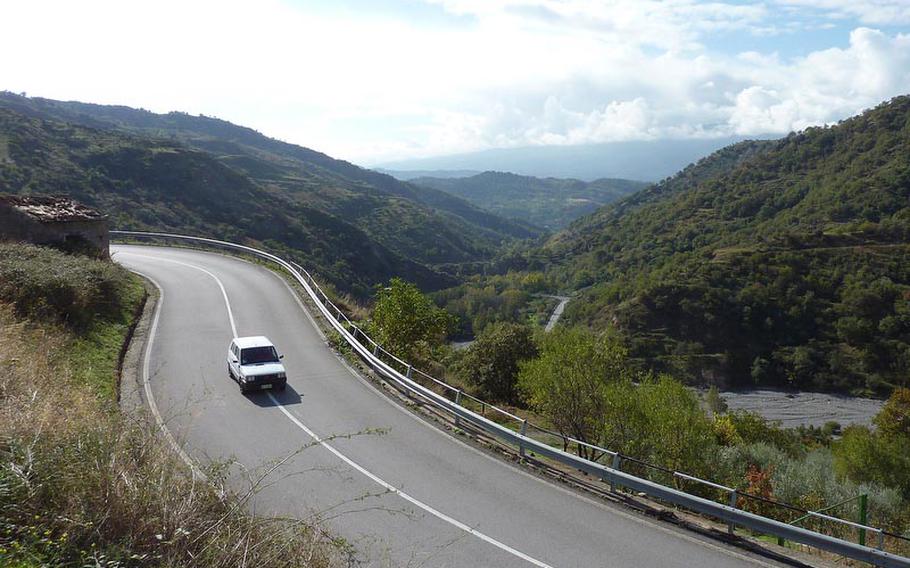
S 185, a serpent of a road, climbs from the Ionian Sea at Giardini-Naxos to well over a 1,000 meters near Novara di Sicilia, then winds back down to the Tyrrhenian Sea near Castroreale Terme. From here, you can follow the coastal road to Tindari. In good weather conditions it is a beautiful alternative to the Autostrada. At center, Mount Etna is obscured by clouds. (Michael Abrams/Stars and Stripes)
The village of Tindari, on Sicily’s northeast coast, has two sites — and sights — that make a visit to this otherwise average Sicilian village worth the trip.
One, the Santuario di Tindari, is a place of pilgrimage; the other, Tyndaris, is the ruins of a Greek-Roman settlement.
The easy way to get there is via the autostrada; the scenic way is via S 113, one of the few roads that cuts through the mountains connecting the shores of the Ionian and Tyrrhenian seas.
The road winds and climbs the mountains. Along the way, cows, sheep, goats and even pigs graze.
On many of the switchbacks, you have a view of Mount Etna, when it is not obscured by clouds.
You come up over a ridge and below, hugging the hillside, is the town of Novara di Sicilia.
From afar, it is quite picturesque; a closer look shows it to be a bit run down. Nonetheless, it is a good place to rest and stretch before continuing downhill to the sea and on to Tindari. There are a few bars to get a cup of coffee, and the town is known for its local maiorchino sheep’s cheese.
Coming down the mountain, you get your first glimpse of the Tyrrhenian Sea, and high on the hillside, visible from miles away, is Santuario di Tindari.
Visitors must park at the bottom of the hill and take a shuttle bus up to the sights, but if the Sicilian sun is not beating down, it is an easy hike.
In a country known for its age-old churches, the sanctuary is young, built in the 1960s. And it was built mainly for one reason, to house the much-revered Madonna Nera, or Black Madonna.
Supposedly found in a case by fishermen in the ninth century, the statue of the Madonna with child is Byzantine in origin. Many miracles have been attributed to the statue, and over the centuries, pilgrims have come to pay their respects to the icon, especially on its feast day, Sept. 8.
The building itself is a huge, soaring dome-topped structure. Inside the dome, the apostles are represented in the stained-glass windows.
The archaeological site of Tyndaris is about a two-minute walk from the sanctuary.
It was founded around 396 B.C. by Greek settlers, and existed through Roman times.
Among the sights here are the ruins of the basilica, a bathhouse, the Casa Romana — a Roman house with mosaic floors — and the theater.
The Greeks sure knew how to pick a spot. Sitting on one of the top rows of the theater, one gets a beautiful panoramic view of the Tyrrhenian Sea.
Although built by the Greeks, the Romans later remodeled the theater. Still later, stones were removed from it to build city walls. The theater is still used in the summer for classical drama and concerts.
The small museum houses the finds of the archaeological site, including a massive stone head of Roman Emperor Augustus.
Also on display is a model of the theater stage.
abramsm@estripes.osd.mil